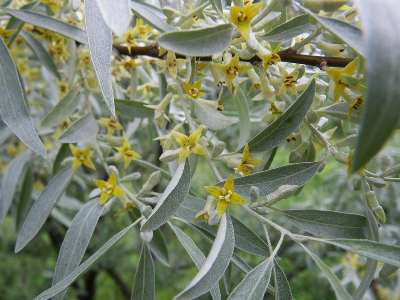FATTY-OXYGEN COMPOSITION OF SEEDS OILS OF SOME WILD-GROWING AND CULTIVATED PLANTS OF THE ASTRAKHAN REGION OBTAINED BY THE SUPERCRITICAL FLUID EXTRACTION METHOD
Abstract
Samples of oils from seeds of wild-growing plants (Elaeagnus angustifoli, Xanthium strumarium, Nelumbo nucifera) and cultivated plants (Sorghum bicolor (L.) Moench, Volzhskoye 51 and Amaranthus cruentus sort Kharkiv 1) in the Astrakhan region, were obtained using supercritical fluid extraction with carbon dioxide in the presence of ethanol as co-solvent. The fatty acid composition of lipid fractions of plant seeds is determined by gas chromatography after conversion to methyl esters of the corresponding fatty acids. The main component of Elaeagnus angustifolia, Xanthium strumarium, Nelumbo nucifera, Amaranthus cruentus and Sorghum bicolor (L.) seed oil is linoleic acid. In addition to it, decadieneal (3.4%), linoleic acid propyl ester (5.7%), 2.5-pentadecadiene-1-ol (0.7%), and 9-oxononanoic acid (1.5%), related to oxygenated acids, were identified. The highest ratio of unsaturated fatty acids to saturated (8.06: 1) is characteristic of the seeds of Elaeagnus angustifoli. A distinctive feature of Amaranthus cruentus seed oil is a high squalene content (6.9%). Peculiarities of the component composition of the oil of the narrow-leaved loch seed are probably due to the soil-climatic conditions of growth and the allelopathic influence of biocenoses.
Downloads
Metrics
References
Schagen S.K., Zampeli V.A., Markantonaki E., Zouboulis C.C. Dematoendocrinol, 2012, vol. 4, no. 3, pp. 298–307.
Bogolitsyn K.G., Kaplitsin P.A., Dobrodeeva L.K., Druzhinina A.S., Ovchinnikov D.V., Parshina A.E., Shul'gina E.V. Sverkhkriticheskie fliuidy: teoriia i praktika, 2016, vol. 11, no. 3, pp. 58–70. (in Russ.).
St. Angelo A.J. Crit. Rev. Food Sci., 1996, vol. 36, no. 3, pp. 175–224.
Temple N.J. Nutr. Res., 2000, vol. 20, no. 3, pp. 449–459.
Jaren-Galan M., Nienaber U., Schwartz S.J. J. Agr. Food Chem., 1999, vol. 47, no. 9, pp. 3558–3564.
Crampon C., Boutin O., Badens E. Ind. Eng. Chem. Res., 2011, vol. 50, no. 15, pp. 8941–8953.
Garcia A., Lucas A.D., Rincon J., Alvarez A., Gracia I., García M.A. J. Am. Oil Chem. Soc., 1996, vol. 73, no. 9, pp. 1127–1131.
Taylor L.T. Supercritical fluid extraction, New York: John Wiley & Sons, Inc., 1996, 181 p.
Blunt M., Fayers F.J., Orr F.M. Jr. Energy Convers. Manag., 1993, vol. 34, no. 9–11, pp. 1197–1204.
Zalepugin D.Iu., Til'kunova N.A., Chernyshova I.V., Poliakov V.S. Sverkhkriticheskie fliuidy: teoriia i praktika, 2006, vol. 1, no. 1, pp. 27–51. (in Russ.).
Pilipenko V.N. Sovremennaia flora i dinamika rastitel'nosti del'ty Volgi: avtoref. dis. … dokt. biol. nauk. [Modern flora and dynamics of vegetation of the Volga delta: dis. ... Doct. Biol. Sciences.]. Astrakhan', 2004, 44 p. (in Russ.).
Ayaz F.A., Kadioğlu A., Doğru A. Tr. J. Botany., 1999, vol. 23, pp. 349–354.
Na Z., Mingyan A., Li L., Huaan F., Na L., Jinguo X. China Oils and Fats., 2013, no. 2, p. 221.
Goncharova N.P., Plugar V.N., Rashkes Ya.V., Isamukhamedov A.Sh., Glushenkova A.I. Chem. Nat. Comp., 1994, vol. 30, no. 6, pp. 661–665.
Scherer R., Wagner R., Meireles M.A.A., Godoy H.T. J. Essent. Oil Res., 2010, vol. 22, no. 5, pp. 424–429.
Bekker G., Domshke G., Fangkhenel' E. Organikum. [Organicum]. Moscow, 1979, vol. 2, 248 p. (in Russ.).


This work is licensed under a Creative Commons Attribution 4.0 International License.
The authors, which are published in this journal, agree to the following conditions:
1. Authors retain the copyright to the work and transfer to the journal the right of the first publication along with the work, at the same time licensing it under the terms of the Creative Commons Attribution License, which allows others to distribute this work with the obligatory indication of the authorship of this work and a link to the original publication in this journal .
2. The authors retain the right to enter into separate, additional contractual agreements for the non-exclusive distribution of the version of the work published by this journal (for example, to place it in the university depository or to publish it in a book), with reference to the original publication in this journal.
3. Authors are allowed to post their work on the Internet (for example, in a university repository or on their personal website) before and during the review process of this journal, as this may lead to a productive discussion, as well as more links to this published work.











